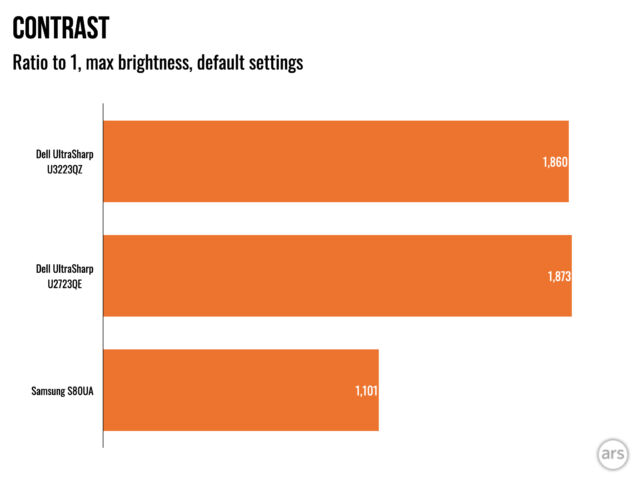IPS Black contrast
Dell's U3223QZ is one of a handful of monitors employing LG Display's IPS Black technology. It's supposed to deliver blacks that are 35 percent darker than regular IPS panels. The primary benefit? A contrast ratio that's said to be twice as high as the typical IPS monitor (2,000:1 versus 1,000:1).
The difference was visible in daily use. To be sure, I set the monitor up next to a traditional IPS monitor, the Samsung S80UA, and I could tell the difference with my naked eyes.
Highlights in dark areas popped a little more, and even highlights in light areas, such as a sunrise, appeared more strongly if I looked closely. It was markedly easier to see details in darker scenes on Dell's IPS Black monitor compared to Samsung's IPS one. Skintones, meanwhile, looked brighter and, at times, showed more lively, golden undertones in areas that were more shadowed on the standard IPS monitor.
Some colors also looked a little stronger. Light greens, for example, appeared a little richer. When I watched a nightclub scene in a movie on the U3223QZ, I could see different shades of orange. But the S80UA turned some of those nuanced shades of orange into red and yellow.
Below is a gallery comparing the U3223QZ IPS Black monitor to Samsung's S80UA. You'll have to take the images with a grain of salt, but you can see differences between the monitors, which are each set to max brightness and their default settings.
-
Dell's UltraSharp U3223QZ IPS Black monitor (left) versus Samsung's S80UAIPS monitor (right).Scharon Harding
-
Dell's UltraSharp U3223QZ IPS Black monitor (left) versus Samsung's S80UAIPS monitor (right).Scharon Harding
-
Dell's UltraSharp U3223QZ IPS Black monitor (left) versus Samsung's S80UAIPS monitor (right).Scharon Harding
-
Dell's UltraSharp U3223QZ IPS Black monitor (left) versus Samsung's S80UAIPS monitor (right).Scharon Harding
I used a Calibrite Colorchecker Display Pro colorimeter to test the U3223QZ's contrast, recording 1,860:1 with the monitor using all default settings except for brightness, which I maxed out.

I could get a little more contrast (1,912:1) if I pushed contrast past the 75 percent default to the max. The image didn't look terrible, but smaller text seemed thinner and harder to read, and some colors, like light blue, looked slightly washed out.
At 200 nits, I recorded the monitor at 1,504:1, which is still better than what we found with the Studio Display at 200 nits (1,040:1).
There are only a few other IPS Black monitors available: the aforementioned Dell UltraSharp U2723QE, the 31.5-inch Dell UltraSharp U3223QE, the 31.5-inch LG 32UQ85R, and the Thunderbolt 4-equipped HP Z32K G3. The U3223QZ, however, stands out with unique features, like the monstrous webcam.
And while this is the second IPS Black monitor we've tested that proves the image quality bump over traditional IPS, contrast levels still don't compare to an OLED monitor, a Mini LED one, or even good VA panels, which are commonly in the 3,000:1 range.
Brightness and color

I set the U3223QZ to its max brightness setting and left all other settings at their default and recorded 405.1 nits. That's in line with Dell's 400-nit claim and what I recorded with Dell's smaller IPS Black monitor. I squeezed a few more nits out of the U3223QZ (441.7 nits) by pushing the contrast setting to the max; however, as discussed in the section above, using these settings made some text harder to read and faded some colors.
On a 31.5-inch panel, 405 nits proved plenty in my well-lit office, even with the display perpendicular to a large, sunny window. I rarely had to push past 75 percent brightness. My review unit showed a decent amount of backlight bleed from the bottom, extending almost halfway up the monitor. However, performance will vary between units.
Viewing angles were impressive. When looking at the monitor from an approximately 90-degree angle, I only had to endure reflections on about a tenth of the screen. Very dark images picked up more reflections, as expected, but dark scenes in movies were still discernible.
With strong viewing angles, 4K daisy-chaining support, and thin side bezels, the U3223QZ could be decent in a multi-monitor setup, although getting a good angle with the webcam may be tricky.

With the monitor in its default color preset, called Standard, my colorimeter recorded 96.8 percent DCI-P3 coverage, which is similar to the other IPS Black monitor in our sample group and comparable to the Studio Display. It's not a huge gain over a strong, traditional IPS monitor, like Samsung's S80UA, but the U3223QZ is still impressively colorful. Dell claims the monitor has a Delta E of <2.
reader comments
73